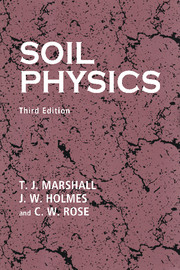Book contents
- Frontmatter
- Contents
- Preface
- Preface to the second edition
- Preface to the first edition
- 1 Composition of soil
- 2 Interaction of soil and water
- 3 Measurement of water content and potential
- 4 Principles of water movement in soil
- 5 Distribution of water in soil
- 6 Ground water in soils and aquifers
- 7 The use of isotopes and other tracers in soil water and groundwater studies
- 8 Soil structure
- 9 Deformation of soil
- 10 Management of soil water
- 11 Soil erosion and conservation
- 12 Chemical transport in soil
- 13 The physical environment of roots
- 14 Plants and soil water
- Appendixes
- References
- Index
8 - Soil structure
Published online by Cambridge University Press: 05 June 2012
- Frontmatter
- Contents
- Preface
- Preface to the second edition
- Preface to the first edition
- 1 Composition of soil
- 2 Interaction of soil and water
- 3 Measurement of water content and potential
- 4 Principles of water movement in soil
- 5 Distribution of water in soil
- 6 Ground water in soils and aquifers
- 7 The use of isotopes and other tracers in soil water and groundwater studies
- 8 Soil structure
- 9 Deformation of soil
- 10 Management of soil water
- 11 Soil erosion and conservation
- 12 Chemical transport in soil
- 13 The physical environment of roots
- 14 Plants and soil water
- Appendixes
- References
- Index
Summary
Definition and description
The solid phase of soil consists of particles of various shapes and sizes packed together in various ways, as discussed in Chapter 1. The packing may be close or open, and the particles may behave either as individuals or as clusters in aggregates. The amount of pore space, its continuity, and the size of the pores vary in a complementary way. These are all aspects of the structure of soil which is defined as the arrangement of the solid particles and of the pore space located between them (Marshall, 1962a).
The structural framework depends on the size distribution of the primary particles and the forces affecting their arrangement. Swelling and shrinking, freezing and thawing, water movement, the growth and decay of plant roots, and the action of earthworms and other animals can all serve in rearranging the particles. Chemical and biological processes mobilise and deposit materials that hold them together as aggregates. The resulting structure and especially the size, shape, and arrangement of the aggregates that can be separated along cracks and natural surfaces of weakness are noted as basic characteristics by soil morphologists. They are consequences of the development of the profile over a long period. But in many ways structure is quite ephemeral since it changes rapidly under common management practices. Soil can, for example, be made less dense by tillage or more dense by compaction, and the fine aggregates of a prepared seedbed may collapse when flooded with water (see Fig. 8.1).
- Type
- Chapter
- Information
- Soil Physics , pp. 199 - 228Publisher: Cambridge University PressPrint publication year: 1996



